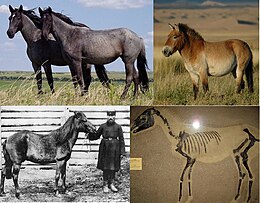| Wild horse | |
|---|---|

| |
| Top left: Equus ferus caballus (horses) Top right: Equus ferus przewalskii (Przewalski's horse) Below left: Equus ferus ferus† (tarpan) | |
| Scientific classification | |
| Domain: | Eukaryota |
| Kingdom: | Animalia |
| Phylum: | Chordata |
| Class: | Mammalia |
| Order: | Perissodactyla |
| Family: | Equidae |
| Genus: | Equus |
| Subgenus: | Equus |
| Species: | E. ferus
|
| Binomial name | |
| Equus ferus Boddaert, 1785
| |
| Subspecies | |
The wild horse (Equus ferus) is a species of the genus Equus, which includes as subspecies the modern domesticated horse (Equus ferus caballus) as well as the endangered Przewalski's horse (Equus ferus przewalskii, sometimes treated as a separate species i.e. Equus przewalskii).[2][3] The European wild horse, also known as the tarpan, that went extinct in the late 19th or early 20th century has previously been treated as the nominate subspecies of wild horse, Equus ferus ferus, but more recent studies have cast doubt on whether tarpans were truly wild or if they actually were feral horses or hybrids.[4][5][6]
Other subspecies of Equus ferus may have existed and could have been the stock from which domesticated horses are descended.[7] Przewalski's horse had reached the brink of extinction, but was reintroduced successfully into the wild.[8] The tarpan became extinct in the 19th century, but is theorized to have been present on the steppes of Eurasia at the time of domestication.[9][10][11][12] Since the extinction of the tarpan, attempts have been made to reconstruct its phenotype using domestic horses, resulting in horse breeds such as the Heck horse.[13][14] However, the genetic makeup and foundation bloodstock of those breeds is substantially derived from domesticated horses, so these breeds possess domesticated traits.
The term "wild horse" is also used colloquially in reference to free-roaming herds of feral horses; for example, the mustang in the United States,[15] and the brumby in Australia.[16] These feral horses are untamed members of the domestic horse (Equus caballus), not to be confused with the truly "wild" horse subspecies extant into modern times.
- ^ King, S.R.B.; Boyd, L.; Zimmermann, W. & Kendall, B.E. (2016) [errata version of 2015 assessment]. "Equus ferus". IUCN Red List of Threatened Species. 2015: e.T41763A97204950. doi:10.2305/IUCN.UK.2015-2.RLTS.T41763A45172856.en. Retrieved 17 February 2022.
- ^ Grubb, P. (2005). "Order Perissodactyla". In Wilson, D.E.; Reeder, D.M (eds.). Mammal Species of the World: A Taxonomic and Geographic Reference (3rd ed.). Johns Hopkins University Press. p. 630–631. ISBN 978-0-8018-8221-0. OCLC 62265494.
- ^ "Explore the Database". www.mammaldiversity.org. Retrieved 20 August 2021.
- ^ Tadeusz Jezierski, Zbigniew Jaworski: Das Polnische Konik. Die Neue Brehm-Bücherei Bd. 658, Westarp Wissenschaften, Hohenwarsleben 2008, ISBN 3-89432-913-0
- ^ "Tarpan". Britannica. Retrieved 7 March 2023.
- ^ "The Przewalskii and Tarpan Horses". Retrieved 7 March 2023.
- ^ Cite error: The named reference
Groveswas invoked but never defined (see the help page). - ^ Goldman, Jason G. "10 Things You Didn't Know About Przewalski's Horses". Scientific American Blog Network.
- ^ "The First Horses: The Przewalskii and Tarpan Horses", The legacy of the horse, International Museum of the Horse, archived from the original on 30 October 2007, retrieved 18 February 2009
- ^ Cite error: The named reference
Groves1994was invoked but never defined (see the help page). - ^ Cite error: The named reference
kavarwas invoked but never defined (see the help page). - ^ Bowling, Ann T.; Anatoly Ruvinsky (2000). "Genetic Aspects of Domestication, Breeds and Their Origin". In Ann T. Bowling; Anatoly Ruvinsky (eds.). The Genetics of the Horse. CABI Publishing. ISBN 978-0-85199-429-1.
- ^ "Tarpan or Heck Horse". horsehints.org.
- ^ "Rare horse breed proves crucial to delicate ecosystem - Features". Horsetalk.co.nz. 1 June 2012. Archived from the original on 9 November 2020. Retrieved 28 May 2017.
- ^ "Black Hills Wild Horse Sanctuary". Black Hills Wild Horse Sanctuary.
- ^ "The Brumbies – Australian Wild Horses › Wild Horses and Mustangs .com". www.wildhorsesandmustangs.com.
